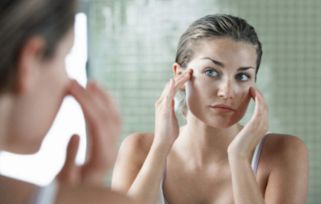In her book Beauty the NewBasics, Rona Berg proposes a skin test that can tell your skin type. First, wash your face, wipe dry, take a few pieces of rice paper or contact lens cleaning paper, and press it on different parts of the face. If the skin is oily, the paper sticks to the face, and when you remove it, you will find transparent oil spots. If the paper doesn't stick to your skin and you don't see clear oil spots when you remove it, then you have dry skin. If the piece of paper sticks only to the T-zone (forehead, nose, chin, etc.), then you have combination skin. Most women have combination skin.

1. Normal skin.
This is the legendary natural beauty. At least you can spend tens of thousands of dollars less on skin care products. The skin is firm and elastic, smooth and moist but not greasy, with small pores and no pigmentation.
However, there are also women who say goodbye to their normal skin after their menstrual holidays. Even if they look white, tender and delicate without pores, oil-absorbing tissue can't absorb oil. You also have dry skin, and you need something moisturizing at this time. Otherwise, you will not be able to spend the seasons comfortably.
For normal care, you can thoroughly clean the skin once a week, and do some facial massage. When massaging, use the middle and ring fingers to make small circles from the bottom to the top and from the inside to the outside. After the massage, you can use electricity, point mask and nutritional cream to make the skin dry. Not greasy.
2. Dry skin.
The appearance of dry skin looks very good, the skin texture is fine, the pores are not obvious, but the skin is dry, dull, rough, lack of elasticity, prone to peeling, or easy to peel off when powder is applied, and prone to pigmentation.
Most of the reasons for the formation are due to the lack of natural sebaceous glands to secrete oil, the sweat glands are not very developed, it is easy to be sensitive and erythema, especially around the eyes and lips, it is easy to wrinkle, and the possibility of microvascular expansion is also increased. The reason may be: drinking water at ordinary times Not enough, staying in an air-conditioned room for a long time, excessive sun exposure, exposure to strong wind, improper use of steam, unsuitable skin care products, unscientific weight loss.
In the choice of skin care products, pay attention to using products with strong moisturizing and moisturizing, or you can choose products containing honey and essential oils.
3. Oily skin.
The face is shiny, and when it reaches a certain level, it can reflect light like a mirror. The skin is relatively thick and not prone to wrinkles. The skin is shiny and delicate, but it is easily contaminated with dirt and dust. Acne, blackheads, etc., are formed due to the strong secretion of sebaceous glands, as well as hormonal stimulation, the environment is too humid and overheated, excessive cleansing of the skin, and eating too much dairy and fried food.
Usually use products that balance sebum secretion, pay attention to cleaning, keep the face fresh, and maintain a normal pH value. You can wash your face with steam to expand the pores of the facial skin, remove the dirt accumulated in the pores, unblock the pores, and replenish the cells needed for metabolism. Moisture, add a few drops of white vinegar to warm water when washing your face, which can effectively clean excess sebum, scaling and dust on the skin.
4. Combination skin.
The T-zone and U-zone (cheeks) of the face are two different combinations. The T-zone is very oily and the U-zone is very dry. Most MM are combination skin, but the skin type will vary with the season and age. , changes in physical condition, etc.
Depending on the nature of the face, you can use products with strong cleaning power on the T-zone, use gentle products on the U-zone, or massage for two more minutes on the T-zone, be sure to remove oil stains, and keep the face fresh and not dry or dry. , This type of skin is best to use less oily nourishing cream.
5. Sensitive skin
Sensitive skin is thinner and has finer pores. If your skin is easily irritated by the sun or some cosmetic products, or is prone to redness, itching or blistering, then it is most likely sensitive. It is especially important to choose the right cleansing products and moisturizers for your skin. Fortunately, many cosmetic brands have products specifically for sensitive skin. It is recommended to choose mild fragrance-free products. Some pharmacies and department stores allow returns, so check the return policy before purchasing. Or ask for a trial product from the place of purchase, and try it carefully before making a decision.
>> Melanotan 2 Supply - Pay on Delivery



